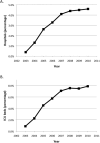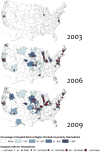Adoption of ICU telemedicine in the United States
- PMID: 24145839
- PMCID: PMC3947050
- DOI: 10.1097/CCM.0b013e3182a6419f
Adoption of ICU telemedicine in the United States
Abstract
Objective: ICU telemedicine is a novel approach for providing critical care services from a distance. We sought to study the extent of use and patterns of adoption of this technology in U.S. ICUs.
Design: Retrospective study combining a systematic listing of ICU telemedicine installations with hospital characteristic data from the Centers for Medicare and Medicaid Services. We examined adoption over time and compared hospital characteristics between facilities that have adopted ICU telemedicine and those that have not.
Setting: U.S. ICUs.
Setting: U.S. hospitals from 2002 to 2010.
Interventions: None.
Measurements and main results: The number of hospitals using ICU telemedicine increased from 16 (0.4% of total) to 213 (4.6% of total) between 2003 and 2010. The number of ICU beds covered by telemedicine increased from 598 (0.9% of total) to 5,799 (7.9% of total). The average annual rate of ICU bed coverage growth was 101% per year in the first four study years but slowed to 8.1% per year over the last four study years (p < 0.001 for difference in linear trend). Compared with non-adopting hospitals, hospitals adopting ICU telemedicine were more likely to be large (percentage with > 400 beds: 11.1% vs 3.7%, p < 0.001), teaching (percentage with resident coverage: 31.4% vs 21.9%, p = 0.003), and urban (percentage located in metropolitan statistical areas with more than 1 million residents: 45.3% vs 30.1%, p < 0.001).
Conclusions: ICU telemedicine adoption was initially rapid but recently slowed. Efforts are needed to uncover the barriers to future growth, particularly regarding the optimal strategy for using this technology most effectively and efficiently.
Conflict of interest statement
The remaining authors have disclosed that they do not have any potential conflicts of interest.
Figures


Similar articles
-
ICU Telemedicine and Critical Care Mortality: A National Effectiveness Study.Med Care. 2016 Mar;54(3):319-25. doi: 10.1097/MLR.0000000000000485. Med Care. 2016. PMID: 26765148 Free PMC article.
-
Characteristics of U.S. Acute Care Hospitals That Have Implemented Telemedicine Critical Care.Crit Care Explor. 2021 Jun 29;3(7):e0468. doi: 10.1097/CCE.0000000000000468. eCollection 2021 Jul. Crit Care Explor. 2021. PMID: 34235456 Free PMC article.
-
Hospital-Level Changes in Adult ICU Bed Supply in the United States.Crit Care Med. 2017 Jan;45(1):e67-e76. doi: 10.1097/CCM.0000000000002051. Crit Care Med. 2017. PMID: 27661861 Free PMC article.
-
Expanding technology in the ICU: the case for the utilization of telemedicine.Telemed J E Health. 2014 May;20(5):485-92. doi: 10.1089/tmj.2013.0102. Epub 2014 Mar 12. Telemed J E Health. 2014. PMID: 24621447 Review.
-
When Will Telemedicine Appear in the ICU?J Intensive Care Med. 2019 Apr;34(4):271-276. doi: 10.1177/0885066618775956. Epub 2018 May 13. J Intensive Care Med. 2019. PMID: 29756527 Review.
Cited by
-
Neurocritical Care Resource Utilization in Pandemics: A Statement by the Neurocritical Care Society.Neurocrit Care. 2020 Aug;33(1):13-19. doi: 10.1007/s12028-020-01001-6. Neurocrit Care. 2020. PMID: 32468327 Free PMC article. No abstract available.
-
Monitoring cardiorespiratory instability: Current approaches and implications for nursing practice.Intensive Crit Care Nurs. 2016 Jun;34:73-80. doi: 10.1016/j.iccn.2015.11.005. Epub 2016 Feb 28. Intensive Crit Care Nurs. 2016. PMID: 26927832 Free PMC article. Review.
-
[Current capabilities of telemedicine in anaesthesiology].Anaesthesist. 2015 Mar;64(3):183-9. doi: 10.1007/s00101-015-0012-z. Anaesthesist. 2015. PMID: 25772604 Review. German.
-
Identifying Strategies for Effective Telemedicine Use in Intensive Care Units: The ConnECCT Study Protocol.Int J Qual Methods. 2017 Jan-Dec;16(1):10.1177/1609406917733387. doi: 10.1177/1609406917733387. Epub 2017 Oct 6. Int J Qual Methods. 2017. PMID: 31528162 Free PMC article.
-
Intensive care unit staffing and quality of care: challenges in times of an intensivist shortage.Rev Bras Ter Intensiva. 2014 Jul-Sep;26(3):205-7. doi: 10.5935/0103-507x.20140031. Rev Bras Ter Intensiva. 2014. PMID: 25295814 Free PMC article. No abstract available.
References
-
- Garland A, Gershengorn HB. Staffing in ICUs: physicians and alternative staffing models. Chest. 2013;143:214–221. - PubMed
-
- Breslow MJ. Remote ICU care programs: current status. J Crit Care. 2007;22:66–76. - PubMed
-
- Lilly CM, Fisher KA, Ries M, et al. A national ICU telemedicine survey: validation and results. Chest. 2012;142:40–47. - PubMed
-
- Pronovost PJ, Angus DC, Dorman T, et al. Physician staffing patterns and clinical outcomes in critically ill patients: a systematic review. JAMA. 2002;288:2151–2162. - PubMed
-
- Siebig S, Kuhls S, Imhoff M, et al. Collection of annotated data in a clinical validation study for alarm algorithms in intensive care--a methodologic framework. J Crit Care. 2010;25:128–135. - PubMed
Publication types
MeSH terms
Grants and funding
LinkOut - more resources
Full Text Sources
Other Literature Sources
Medical

